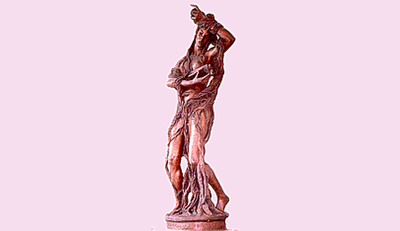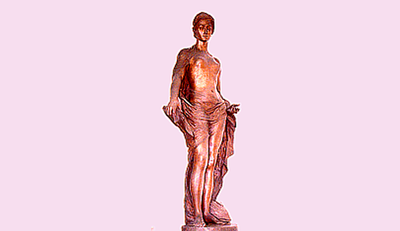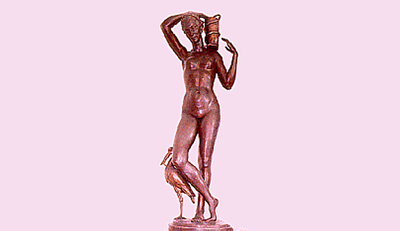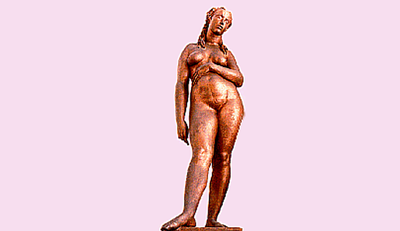In the atrium of the Rectorship of the University of Cagliari, in via Università 40, are placed four statues made and placed in 1964 during the initiatives for the second centenary of the restoration of the University, implemented in 1764 by the will of the Savoy King Charles Emmanuel III. The four statues, acquired on the initiative of the Rector Giuseppe Peretti in collaboration with the art and culture expert Rodolfo Siviero, represent Philosophy, Law, Medicine, Science and Technology.
Address: Rectorship of the University of Cagliari, Via Università, 40 - 09124 Cagliari
One of art oldest images is the human figure, and around this concept over the centuries have alternated classical harmony, pantheism and Christianity of the Renaissance; so much so that Leonardo da Vinci wrote: "man is the measure of the world".
The four statues depicting the ancient disciplines of the University of Cagliari were therefore to represent human dignity.
The great discoveries of intelligence that have illuminated decades of the nineteenth and early twentieth centuries, the merry singing of Manet’s colours, Picasso’s cubism, De Chirico’s metaphysics, are all personal discoveries, but they represent life and research of their times. The statues of Cagliari are part of the Italian tradition, they continue their studies, they embody the course of study youth follow, and they are a discipline as well.
Changes in human society occur by natural growth such as that of trees and things, therefore experiences that are ends in themselves, sophistications that do not correspond to a true intent of artistic research, create deep disorientation in consciences and betray the very meaning of art, which is always a difficult conquest of universal values. When this intellectual confusion, which has manifests itself in abstraction art, informal art, and other similar attempts will find its order and its logos, the new face of art will discover the new aspect of the human infinite.
These statues represent the school from which one must always build or rebuild that new art that will develop alongside the common progress of all peoples, one that now does not seem to be appreciated by anyone in Italy. For this reason, we preferred reality to the controversy, a tiring reality indeed, because beauty and truth really unite only at the highest level. What remains in time are the values of art and the moral qualities, both opposed by petty men; but as the spirit prevails, so true art does not die and is constantly rediscovered.
These realities in our time are bewildered by the infinite noises that surround them and surround them, but as these die for natural inconsistency, those remain.
The statues of Cagliari are a life lesson that the Rector of the University and the Academic Senate wanted to welcome into their university; I am pleased to have been the link.
Rodolfo Siviero

Characteristics
Author: Antonio Berti (San Piero a Sieve - Florence 1904)
Material: bronze
Height: m 2,40
Antonio Berti wrote of this work: "When my friend Rodolfo Siviero proposed four subjects for a statue, I enthusiastically chose Philosophy. The theme captivated me, and I did four studies: two naked figures with a crow, the other two wrapped in large and long masses of hair. I made the last sketch to the desired size. I looked in the clay the likeness of a being pervaded by the desire to explain the reason of things. The tense features of the face denounce this wear of the brain and spirit. The mouth is open, yearning for the torment of knowing; the gaze is immersed in the deep conception of thought. The long hair snakes like a river along the young woman’s limbs. The left hand raises like a veil a mass of hair to get out of front something that prevents it from understanding the reason for our birth to life, our going towards death. " With great passion and humility, I tried to do something worthy of the theme entrusted to me. I thank those who have offered me this opportunity, begging them to welcome my work with the others, as an act of courage and faith in Art in a moment of such great bewilderment".

Characteristics
Author: Bino Bini (Florence 1916)
Material: bronze
Height: m 2,32
Bini Bini wrote of this work: "There is no traditional symbology for the study of law in its various forms, since Jurisprudence is a thing, and Justice is another thing entirely. It was therefore necessary to entrust to the expression of the figure the task of clarifying its allegory. It was necessary that the sculpture was animated with human warmth, that gave the sensation of an unshakeable, incorruptible stability; that it carried marked in the face the severity and sweetness, the will and the understanding and a veil of melancholy suffused with feeling. I don’t know to what extent I succeeded. My sympathy for animals has meant that in this work I didn’t forget them. At the woman’s feet a porcupine plays with a veil flap, symbolically ready to gather with quills in defense of the right".

Characteristics
Author: Mario Moschi (Signa - Florence 1896)
Material: bronze
Height: m 2,30
Mario Moschi wrote about the work: "For me sculpture is also architecture. The theme of medicine interested me, and I chose it because with its classic attributes, the stork and the snake, it allowed me to build a harmonious subject, responding to my feeling of art. Each fragment of sculpture has its own life, and this is what I have searched in the details of the statue. The play of the elements led me to conclude a rhythmic set; it’s necessary, because medicine has for me the meaning of the preservation of life, which is beauty and harmony".

Characteristics
Author: Francesco Messina (Linguaglossa 1900)
Material: bronze
Height: m 1,92
On this work Francesco Messina wrote: "When the ghost of a statue moves in the artist’s imagination and causes the urgency of realisation, it is always the plastic, chiaroscuro, lyrical factor, which imposes a meaning and, therefore, a subject. It is called Demeter, Venus, Eve, or simply "female figure", or as in our case, "Science", the most authentic emotion, which must necessarily and primarily release will always be the form of the arabesque design in harmony of volumes, as the sculpture of all time requires.
A statue is either beautiful or dead matter, if it is not inspired by the poetic inspiration of the author".
